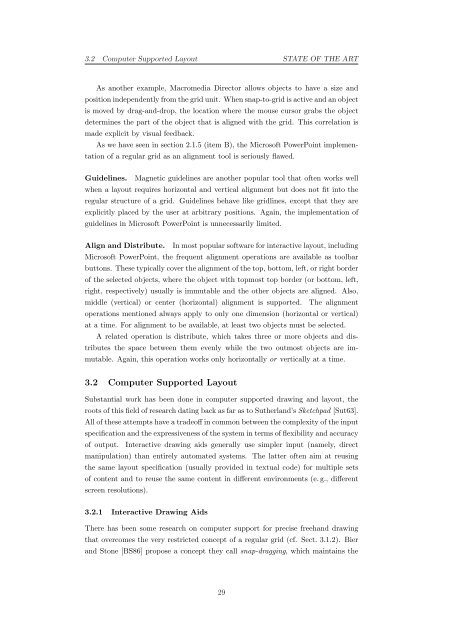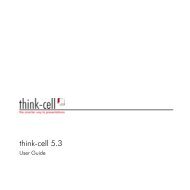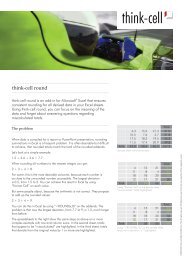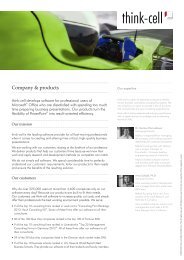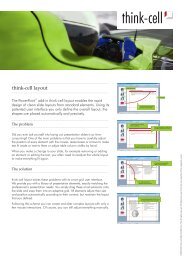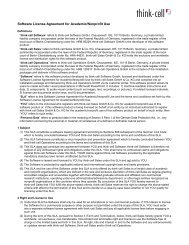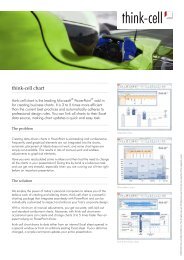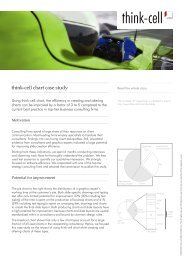think-cell technical report TC2003/01 A GUI-based Interaction ...
think-cell technical report TC2003/01 A GUI-based Interaction ...
think-cell technical report TC2003/01 A GUI-based Interaction ...
Create successful ePaper yourself
Turn your PDF publications into a flip-book with our unique Google optimized e-Paper software.
3.2 Computer Supported Layout STATE OF THE ART<br />
As another example, Macromedia Director allows objects to have a size and<br />
position independently from the grid unit. When snap-to-grid is active and an object<br />
is moved by drag-and-drop, the location where the mouse cursor grabs the object<br />
determines the part of the object that is aligned with the grid. This correlation is<br />
made explicit by visual feedback.<br />
As we have seen in section 2.1.5 (item B), the Microsoft PowerPoint implemen-<br />
tation of a regular grid as an alignment tool is seriously flawed.<br />
Guidelines. Magnetic guidelines are another popular tool that often works well<br />
when a layout requires horizontal and vertical alignment but does not fit into the<br />
regular structure of a grid. Guidelines behave like gridlines, except that they are<br />
explicitly placed by the user at arbitrary positions. Again, the implementation of<br />
guidelines in Microsoft PowerPoint is unnecessarily limited.<br />
Align and Distribute. In most popular software for interactive layout, including<br />
Microsoft PowerPoint, the frequent alignment operations are available as toolbar<br />
buttons. These typically cover the alignment of the top, bottom, left, or right border<br />
of the selected objects, where the object with topmost top border (or bottom, left,<br />
right, respectively) usually is immutable and the other objects are aligned. Also,<br />
middle (vertical) or center (horizontal) alignment is supported. The alignment<br />
operations mentioned always apply to only one dimension (horizontal or vertical)<br />
at a time. For alignment to be available, at least two objects must be selected.<br />
A related operation is distribute, which takes three or more objects and dis-<br />
tributes the space between them evenly while the two outmost objects are im-<br />
mutable. Again, this operation works only horizontally or vertically at a time.<br />
3.2 Computer Supported Layout<br />
Substantial work has been done in computer supported drawing and layout, the<br />
roots of this field of research dating back as far as to Sutherland’s Sketchpad [Sut63].<br />
All of these attempts have a tradeoff in common between the complexity of the input<br />
specification and the expressiveness of the system in terms of flexibility and accuracy<br />
of output. Interactive drawing aids generally use simpler input (namely, direct<br />
manipulation) than entirely automated systems. The latter often aim at reusing<br />
the same layout specification (usually provided in textual code) for multiple sets<br />
of content and to reuse the same content in different environments (e. g., different<br />
screen resolutions).<br />
3.2.1 Interactive Drawing Aids<br />
There has been some research on computer support for precise freehand drawing<br />
that overcomes the very restricted concept of a regular grid (cf. Sect. 3.1.2). Bier<br />
and Stone [BS86] propose a concept they call snap-dragging, which maintains the<br />
29


